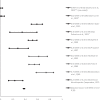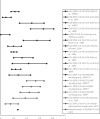Withdrawal of antihypertensive medication: a systematic review
- PMID: 28486271
- PMCID: PMC5548513
- DOI: 10.1097/HJH.0000000000001405
Withdrawal of antihypertensive medication: a systematic review
Abstract
: Although antihypertensive medication is usually continued indefinitely, observations during wash-out phases in hypertension trials have shown that withdrawal of antihypertensive medication might be well tolerated to do in a considerable proportion of people. A systematic review was completed to determine the proportion of people remaining normotensive for 6 months or longer after cessation of antihypertensive therapy and to investigate the safety of withdrawal. The mean proportion adjusted for sample size of people remaining below each study's threshold for hypertension treatment was 0.38 at 6 months [95% confidence interval (CI) 0.37-0.49; 912 participants], 0.40 at 1 year (95% CI 0.40-0.40; 2640 participants) and 0.26 at 2 years or longer (95% CI 0.26-0.27; 1262 participants). Monotherapy, lower blood pressure before withdrawal and body weight were reported as predictors for successful withdrawal. Adverse events were more common in those who withdrew but were minor and included headache, joint pain, palpitations, oedema and a general feeling of being unwell. Prescribers should consider offering patients with well controlled hypertension a trial of withdrawal of antihypertensive treatment with subsequent regular blood pressure monitoring.
Figures




Comment in
-
Antihypertensive therapy: strategic withdrawal or a mandatory life sentence?J Hypertens. 2017 Sep;35(9):1778-1779. doi: 10.1097/HJH.0000000000001416. J Hypertens. 2017. PMID: 28767485 No abstract available.
-
False reassurance about the consequences of withdrawing antihypertensive drug therapy.J Hypertens. 2018 Feb;36(2):447-448. doi: 10.1097/HJH.0000000000001616. J Hypertens. 2018. PMID: 29611839 No abstract available.
References
-
- CAPSP. Critical Appraisal Skills Programme (CASP). CASP, UK; 2013. Available from: http://www.casp-uk.net/#!casp-tools-checklists/c18f8. [Accessed 9 June 2016].
-
- Fernandez PG, Galway AB, Kim BK. Prolonged normotension following cessation of therapy in uncomplicated essential hypertension. Clin Invest Med 1982; 5:31–37. - PubMed
-
- Nelson MR, Reid CM, Krum H, Ryan P, Wing LM, McNeil JJ. Management Committee, Second Australian National Blood Pressure Study. Short-term predictors of maintenance of normotension after withdrawal of antihypertensive drugs in the second Australian National Blood Pressure Study (ANBP2). Am J Hypertens 2003; 16:39–45. - PubMed
-
- Herlitz H, Hartford M, Ljungman S, Jonsson O, Wikstrand J, Berglund G. Different patterns of cellular sodium turnover in essential hypertension. J Hypertens Suppl 1988; 6:S213–S215. - PubMed
-
- Fernandez PG, Kim BK, Galway AB, Sharma JN. Separation of essential hypertensive patients based on blood pressure responses after the withdrawal of antihypertensive agents by step-wise discriminant analysis. Curr Med Res Opin 1983; 8:509–517. - PubMed
Publication types
MeSH terms
Substances
Grants and funding
LinkOut - more resources
Full Text Sources
Other Literature Sources
Medical

